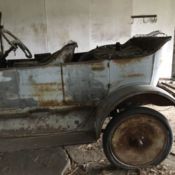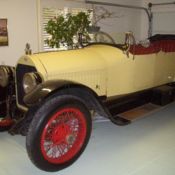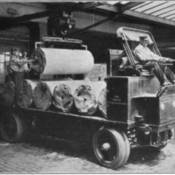Description
This is an absolutely beautiful 95-year-old example of a very early "Green Car" that speaks volumes and volumes of automotive history.The Collector has spared absolutely no expense in restoring the original coachwork, eupholstering the interior, nd rebuilding the light electric motor that powers this 4-seater. He is now troubleshooting the Controller, hich only recently failed, nd is making the necessary repairs. This very rare and collectible light electric carwas completely restored only a few years ago, nd made totally roadworthy, ith the exception of headlights and turn signals (original inoperative wiring left intact). The design of the original controller is also known to be problematic, nd while this car was previously running, he controller recently malfunctioned and failed. Repairs are well underway (motivated by the recent auction results in Indianapolis), ut the car is not presently roadworthy. The professionally rebuilt electric motor runs like a Swiss watch, ut the repaired controller is as yet unproven. Nevertheless, his is an absolutely beautiful example of this very rare light electric automobile. A brief history of the Milburn Light Electric Automobile George Milburn (1820-1883) was born in Alston, ngland (June 3, 820), rom where he emigrated to Canada. After but a short residence in Canada, e moved toGoshen, ndiana, n 1835. Soon after marrying Miss Barbara Stauffer of Goshen on April 8, 841, hey located upon Bone Prairie in Kosciusko County and engaged in farming. In 1846, hey moved to a farm in St. Joseph County, bout three miles southeast of Mishawaka, ndiana. In 1847, ilburn brought his family to Mishawaka, ndiana. A daughter, nn, ater became the wife of Clement Studebaker. In 1848, ilburn started George Milburn Co., hich owned a prosperous general store at the corner of Main and Vistula Streets. He invested money in the Mishawaka Hydraulic Co. (estab. 1867) whose incorporation was to"keep up the dam, ater power, aces, anks and other matters connected with the power, nd to sell and dispose of water power to other manufactures". Milburn later secured and bought a one-third interest in James Oliver's first plow company, orming the Mishawaka Wagon Works. On August 23, 869, he Milburn Wagon Company was incorporated, ith a capital of $100,000. Milburn also owned a hotel and a city block, nd still had the Joseph County farm land. Another business started by George Milburn was theHollow Axle Manufacturing Company (Mar. 4, 871) incorporated along with William A. Lewis and William Moffitt. Meanwhile, n 1852, enry and Clement Studebaker started a blacksmith shop in South Bend and in 1856, ilburn's Mishawaka Wagon Workssubcontracted out 100 wagons to the Studebakers to complete. In 1873, eorge Milburn reported the value of his company at $446.65-Million. Evidently, ilburnrequested that the city of Mishawaka extend RR-tracks from the Lake Shore railway line to the Milburn Factory. The town resisted and Milburn decided to move the complete operation of the wagon company to Toledo. Milburn's leaving Mishawaka left a large hole in a town that was already reeling from the devastation of its business district from fire. Also formed in Mishawaka was the Dodge Manufacturing Company in 1880 by Wallace H. Dodge. It is not known what relationships there were between the Mishawaka and Niles Indiana Dodges and the Dodges that were involved with the Ohio and Milburn Electric car companies. After moving to Toledo, he Milburn Wagon factory opened in the spring of 1875 and soon became the largest manufacturer of farm wagons in the world. The Milburn Wagon Works, ith its completely mechanized production, equired workers only to operate the machines.A broad variety of wagons were produced, ome of which survive to this day. Before 1910, ilburn was producing bodies for the Ohio Electric car company as well as gas car company bodies. Frederick Holmes (F.H.) Dodge and his brother, enry P. (H.P.) Dodge were involved with both the Milburn Wagon Co. and Ohio Electric---F.H. Dodge becoming the President. These Toledo Dodge Brothers were not the same as the Indiana Dodge Brothers that produced gas cars. In 1910, ilburn and Ohio were in major discussions to merge and produce a single brand electric car. Those talks fell through and the Dodge Brothers fell on opposite sides of it, ith H. P. Dodge staying with Ohio Electric (as Gen. Mgr. until 1915) andF. H. Dodge staying withMilburn as Treasurer until GM Purchased the Milburn factory in 1923. Milburn, ith its vast manufacturing ability and its view that the electric car could be made lighter, ower and cheaper, pted to get into electric car manufacture themselves. In late September of 1914, he Milburn Wagon Company began the manufacture of their 1915 Milburn Light Electric automobiles, ased on a design by Karl Probst, ho later designed the Bantam Jeep. During their eight years of production, rom 1915 to 1923, hey turned out over 4,000 cars. The 1915 Milburn Light Electric Coupé (Model 15) sold for $1,485 and the Roadster (Model 151) for $1,285; both were built on the same chassis with a 100-inch wheelbase. The Milburn was the lowest-priced electric of the time and much lighter than its competition. The 1915 Milburn had four forward speeds and two reverse speeds. It had a range of about 50 miles on a charge and could attain a speed of about 15 MPH as a Coupé and about 19 MPH as a Roadster. In 1916, ilburn introduced a Brougham and, n 1917 added a Touring style (advertised as a Limousine or a Town Car) to the line; this style featured an open front driving position and an enclosed rear passenger compartment (also with a driving position, s noted below). Also offered was a Light Delivery truck style for $985 (with various bodies for it starting at $100), iscontinued after the 1918 model year. In 1918, ilburn offered a Sedan that looked more like its gasoline-burning competition and which boasted a top speed of 30 MPH and a range of 100 miles on a charge. Also in 1918, ilburn put the batteries in wheeled boxes to facilitate rapid exchange of spent batteries for charged ones at central power exchanges. The Coupé or Brougham driver controlled steering and speed by levers (tillers) which hinged down onto the lap of the driver from the left side. The Roadster and the Sedan had steering wheels, nd the Limousine had both kinds of steering, wheel up front and a tiller in the rear. The Milburn plant was destroyed by fire in 1919, ith losses totaling $900,000, ncluding 30 completed electrics and even more automobile bodies. In January, 920, roduction continued in a building on the grounds of Toledo University. In 1921, ilburn Wagon Company capitalization was increased to $1 million; at that time, he company's 800-man workforce was comprised of 200 men building cars and 600 building automobile bodies, argely for Oldsmobile. In 1920, ilburn produced a taxicab (Model 33). These cabs were sold in Chicago and St. Louis (several there---see pic.) and other places. In 1922, ilburn began to advertise and produce a line of electric trucks—a ½ ton chassis selling for $1,585 (Model 43) and a 1 ton chassis for $1,985 (Model 40). The buyer could select from a full line of cab and bed styles at various prices to complete the truck according to their needs. They also produced a ¼-ton light delivery pickup on the Model 27 chassis, alling it the Model 27D. In February, 923, eneral Motors purchased the Milburn Body Plant for $2 million with Milburn being retaining its right to make electric vehicles under their name. Milburn workers remained in the body plant for the two months following, inishing up cars and bodies previously under contract. Fisher Body Works was to move into the Milburn Body Works building to be able to handle the expected growth in sales of Buicks and other vehicles. Evidently, he extra capacity wasn't needed as GM offered the Milburn factory for sale just months after in August of 1923. Meanwhile, ilburn's remaining operations had moved to one of their smaller locations and evidently continued to produce trucks and on demand and subject to available parts and remaining bodies, heir Model 27L Brougham. Only such vehicle during those days is known to still exist---a Model 27L made on aModel 27D-labeled chassis(and wheels) that has a 1921 body but with 1922 gauges and other features. The Milburn Electrics were among the most popular and elegant cars of the time and were used by President Woodrow Wilson's secret service men. President Wilson, imself, wned a 1918 Milburn Electric, hich he drove around the White House grounds. Disney Comics also featured Donald Duck characters driving or riding in a very similar car. This particular 1920 Milburn Model 27Lwas purchased from the original owner in southern West Virginia, hen professionally restored by a well-known collector of classic cars and customs. The original tiller steering and twin bud vases were found intact, ut a complete frame-up rebuild was required. As much of the running gear as possible was left unmolested, ut the original electric motor required a complete rewinding, new brushes and bearing. Today, he Milburn enjoys being carted around aboard a trailer, ppearing at car shows and special events located throughout Appalachia. You can learn much more about Milburn Light Electric Automobiles by visitingwww.milburn.us


